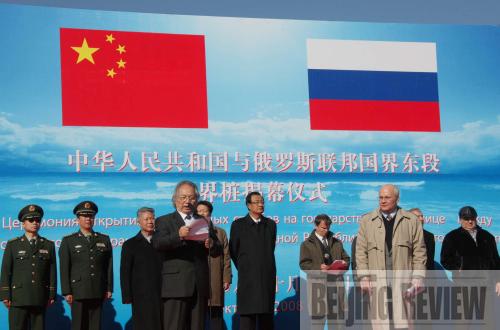|
Gorbachev's new philosophy illustrated an innovative concept of national security. Moreover, not only did he advocate a political means with which to address international issues, he also believed there were extensive fields of cooperation possible between China and the Soviet Union.
In addition to common bilateral interests, he strongly felt, the two countries shared similar—and indeed even coincidental—standpoints in international affairs, too.
In May 1989, Gorbachev paid a groundbreaking visit to China, where he expressed his strong desire to normalize bilateral relations. Subsequently, Sino-Soviet relations began to markedly improve—and 30 years of tense confrontation came to an end.
Healthy development
Events soon after, while turbulent, did little to affect Chinese relations with Moscow after the Soviet Union disintegrated on December 25, 1991.
China soon sent a governmental delegation to Moscow and declared its intention to recognize the Russian Federation and its seat in the UN Security Council. Sino-Russian relations maintained a smooth continuity, initiated steady development and kept making headway.
In late January 1992, relations furthered as then Chinese Premier Li Peng met with former Russian President Boris Yeltsin at the UN, promising to further develop friendly relations between the two countries.
 |
|
A PEACEFUL BORDER: Zhao Xidi (left front), an official with the Chinese Foreign Ministry's Department of European-Central Asian Affairs, and Vladimir Malyshev (right front), Deputy Director of the Russian Foreign Ministry's First Asian Department, attend the ceremony to unveil boundary markers in the eastern section of the China-Russia border on Heixiazi Island, in northeast China's Heilongjiang Province, on October 14, 2008 (WANG YONGJI) | At the end of that year, Yeltsin paid his first visit to China. The two sides issued the Joint Statement on the Basis of Mutual Relations, recognizing each other as friendly countries. The two powers had thus embarked on a new type of state-to-state relations—one based on non-confrontation, non-alignment, good neighborliness and mutually beneficial cooperation.
In September 1994, former Chinese President Jiang Zemin toured Russia. During his visit, both sides formalized a series of agreements, including a joint statement, and an agreement on neutralizing nuclear weapon threats against each other. Thus a constructive partnership for the 21st century was established.
Four years later, in April 1996, Yeltsin paid his second visit to Beijing. The two sides reached a consensus on coordination and cooperation regarding major international issues in a Sino-Russian joint statement, and established a strategic partnership of cooperation for the 21st century based on equality and mutual trust, ushering in a new era of Sino-Russian relations.
Deepening cooperation
Since then—and, in particular, the beginning of the 21st century—Sino-Russian relations have continued to deepen.
First, political ties have further strengthened. During the eight years of Putin's presidency, Sino-Russian political contacts increased in their practicality. In July 2001, for instance, the two sides signed the Treaty of Good Neighborliness and Friendly Cooperation to last 20 years.
It was nothing less than a landmark achievement in the development of Sino-Russian relations, as it established a legal framework for the two countries' efforts to become "good neighbors, good partners and good friends." It also laid a solid foundation for their long-term good neighborliness and mutually beneficial cooperation.
Under the guidance of the treaty, political trust between the two sides has continued to improve. In 2005, Chinese President Hu Jintao visited Russia and signed the Joint Statement on the International Order of the 21st Century with Putin. In this document, the two presidents reiterated their countries' positions on establishing a new international order that is just and fair.
In addition, the two countries decided to hold the Year of Russia in China in 2006 and, in turn, the Year of China in Russia in 2007. Meanwhile, China is hosting the Year of the Russian Language this year, and the Year of the Chinese Language will be held in Russia in 2010. Each event will feature programs designed to help promote friendship and strategic cooperation.
Second, the two countries' longstanding border disputes have been solved. On October 14, 2008, the two sides held a joint ceremony to unveil boundary markers on the eastern section of the border between China and Russia. With this move, the two nations have completed the demarcation of their 4,300-km-long border.
Third, economic cooperation has developed soundly and the areas of cooperation are enlarging. When China and Russia established their strategic partnership of cooperation 13 years ago, bilateral trade volume was less than $10 billion. There were three bottlenecks—bank settlement, arbitration mechanisms and export credit insurance—that were difficult to break through.
After taking office as Russian president in 2000, Putin actively promoted Sino-Russian economic and trade cooperation and issued a series of policies favorable for attracting investments from overseas. As a result, bilateral trade between China and Russia maintained an annual growth rate of the double digits for eight years, increasing from $5.7 billion to nearly $57 billion.
|
